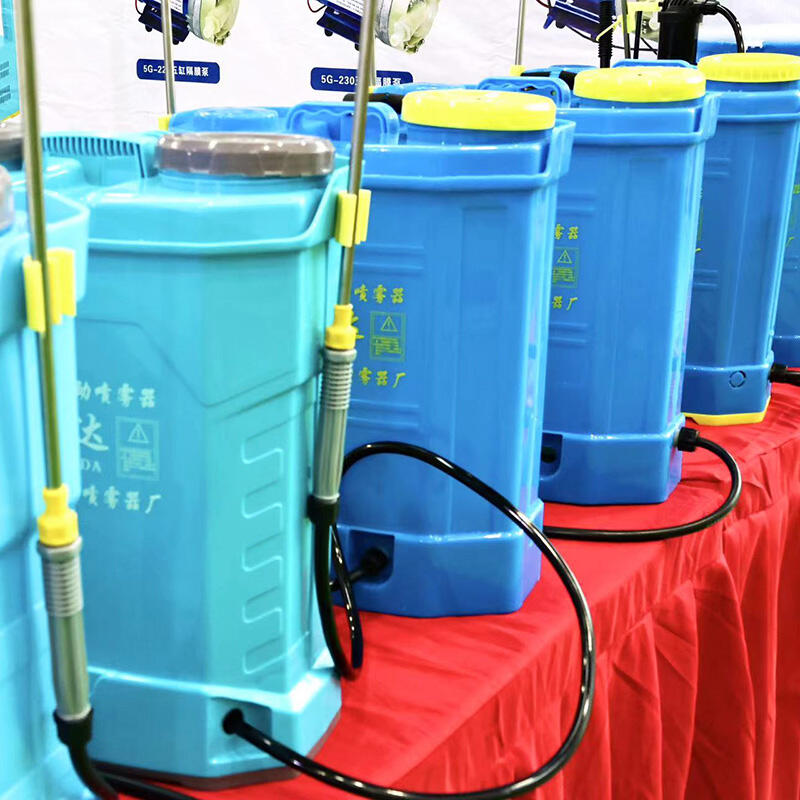The Rise of Portable Sprayers in Modern Agriculture
From Backpacks to Battery Power: Evolution of Sprayer Technology
The transition from manual to battery-powered sprayers marks a significant advancement in agricultural technology, improving efficiency by up to 40%. Historically, backpack sprayers were the norm in farming, requiring significant manual labor and time investment. As technology evolved, battery-powered options emerged, revolutionizing traditional methods by offering increased coverage, precision, and ease of use. This shift not only reduced the physical strain on laborers but also allowed farmers to manage larger areas more effectively, showcasing the potential of modern sprayer technology to significantly enhance agricultural efficiency.
Meeting Small-Scale Farmers' Unique Needs
Portable sprayers have become essential tools for small-scale farmers, addressing challenges such as limited budgets and varied crop types. With specific designs catering to affordability and ease of use, these sprayers help farmers optimize their resources. A notable statistic reveals that 61% of small farmers now use some form of portable sprayers to boost productivity. This adoption highlights the critical role portable sprayers play in enabling farmers to manage their diverse crops efficiently and economically, fostering sustainable practices in small-scale agriculture.
Types of Portable Agricultural Sprayers
Manual Backpack Sprayers (Knapsack Models)
Manual backpack sprayers offer unparalleled flexibility and are cherished for their economical pricing. These sprayers, often referred to as knapsack models, are designed with the user in mind, featuring straps for easy carrying and operation. The advantage of manual sprayers lies in their ability to adapt to various terrains and crop types, making them suitable for small-scale and urban farms. Comparative analysis of leading knapsack sprayer reviews shows that these models excel in durability, efficiency, and user comfort, providing a reliable option for spraying tasks without the need for heavy machinery. For instance, they've been praised for not only precision spraying but also their ease of cleaning and maintenance, aspects critical for productive agricultural practices.
Electric/Battery-Powered Sprayers
Electric or battery-powered sprayers have revolutionized agricultural spraying by offering increased convenience and speed, especially over large fields. These sprayers eliminate the requirement for manual pumping, thereby reducing labor-related fatigue, which is a significant advantage for farmworkers. The sprayers are equipped with powerful batteries ensuring extended usage durations, while standardized charging protocols simplify maintenance and uptime. Discussing battery life, modern models can operate for several hours, ensuring that even extensive fields can be covered efficiently. This ease of use and adaptability makes electric sprayers an indispensable tool for optimizing agricultural operations and enhancing productivity.
Fertilizer Applicator Attachments
Portable sprayers equipped with fertilizer applicator attachments present a versatile solution for simultaneous spraying and fertilization processes. This dual functionality optimizes resource use, eliminating the need for separate equipment to address these agricultural tasks. The versatility of these sprayers is evident as they enable farmers to efficiently nourish crops while protecting them from pests. In regions like the Midwest, evidence shows increased crop yields attributed to the adoption of such dual-purpose sprayers. These outcomes underscore the importance of integrated systems in boosting agricultural output and supporting sustainable farming practices.
Specialized Systems for Fruit Tree Cultivation
Sprayers tailored for fruit tree cultivation address unique challenges by offering specialized systems capable of navigating narrow rows without compromising the health of the plants. These designs ensure that crops receive adequate protection from pests without the risk of mechanical damage. Farmers who have adopted specialized fruit tree sprayers report improved pest control and healthier yields. Case studies illustrate the tangible benefits, depicting enhancements in production and reduction in crop loss. Such systems underscore the importance of targeted spraying technology in supporting the varied needs of modern agriculture, particularly in fruit cultivation sectors.
Key Benefits Transforming Farm Operations
Precision Application for Optimal Crop Health
Precision application plays a pivotal role in optimizing crop health and minimizing chemical usage. Portable agricultural sprayers enable farmers to apply pesticides and fertilizers precisely where needed, ensuring that crops receive the exact nutrients and protection required for healthy growth. This targeted approach not only promotes healthier crops but also reduces the overall quantity of chemicals used, mitigating environmental impact. According to recent data, targeted spraying practices have led to a remarkable 30% reduction in chemical runoff, showcasing the effectiveness of precision application techniques in preserving ecosystem health.
Labor Efficiency in Challenging Terrains
Portable sprayers significantly enhance labor efficiency, especially in challenging terrains where traditional methods may falter. These devices allow farmers to cover larger areas quickly, reducing the need for manual labor and enabling efficient handling of difficult landscapes. Farmers have shared testimonials illustrating cost savings and improved operational efficiency through the adoption of portable technology. By equipping workers with reliable tools, labor costs can be reduced while productivity remains high, thereby transforming farm operations to be both effective and economically viable.
Water Conservation Through Targeted Spraying
Targeted spraying techniques contribute greatly to water conservation, a crucial aspect of sustainable agricultural practices. By focusing water and chemical applications precisely where needed, these methods reduce water usage by up to 30% compared to conventional spraying techniques. Such practices align with initiatives advocated by environmental organizations striving for water conservation in agriculture. As water scarcity becomes an increasingly pressing issue, employing targeted spraying methods can significantly impact the reduction of water consumption, ensuring that resources are used efficiently and responsibly for future farming endeavors.
Choosing the Right Portable Sprayer
Assessing Farm Size and Crop Types
Choosing the right portable sprayer for your farm involves considering key factors such as farm size and crop types. Begin by assessing the size of your farm; larger farms may require sprayers with greater capacity and wider spray coverage to efficiently manage various crop types. Crop types play a significant role in determining the suitable sprayer, as different crops may require specific nozzle types for effective application. Additionally, consider scalability as crop requirements can evolve over time, demanding adjustments in sprayer configurations to accommodate these changes.
Comparing Pump Systems: Manual vs Electric
When deciding between manual and electric pump systems for portable sprayers, understanding the distinct characteristics of each is crucial. Manual pumps offer simplicity and lower maintenance costs but can be labor-intensive, especially for larger farming operations. In contrast, electric pumps provide enhanced performance metrics, making them suitable for extensive agricultural applications, though they may entail higher upfront costs and maintenance needs. Expert opinions suggest considering farm environments—electric pumps are better suited for larger farms requiring frequent spraying, whereas manual pumps are ideal for smaller or less demanding landscapes.
Understanding Sprayer Capacity Ratings
Sprayer capacity ratings are essential for determining the efficiency of a sprayer in meeting specific operational needs. These ratings help users select the most appropriate sprayer size based on the volume of liquid it can hold, which directly impacts its effectiveness and overall farm productivity. Larger capacity sprayers can cover extensive areas without frequent refilling, enhancing operational efficiency. Understanding these ratings allows farmers to choose a sprayer that aligns with their farm's demands, ensuring optimal performance and productivity.
Maintenance and Future Innovations
Essential Cleaning and Storage Practices
Maintenance of portable sprayers is paramount for extending their lifespan and keeping them in optimal condition. Regular cleaning is essential to prevent clogs and corrosion, especially if the sprayer is used for applying fertilizers or pesticides. After each use, the tank should be thoroughly rinsed, and all nozzles should be cleaned to avoid residue buildup. Proper storage, such as ensuring the sprayer is completely dry and kept in a sheltered area, can remarkably extend its functionality. In fact, statistics show that diligent maintenance can enhance equipment longevity by up to 50%, making these practices crucial for sustaining performance and reducing long-term costs.
Nozzle Optimization for Various Crops
Nozzle optimization is integral for maximizing the efficiency of portable sprayers across different crop types. Each crop may require specific spraying patterns or droplet sizes, and selecting the right nozzle can significantly improve application efficiency while minimizing waste. Agricultural studies have proven that optimized nozzles can enhance spray coverage, thereby increasing the effectiveness of pest and disease control measures. For example, using adjustable nozzles allows for tailored applications that align with varying plant structures and densities, which not only boosts productivity but also promotes more sustainable farming practices.
Integrating with Agricultural Irrigation Pumps
Integrating portable sprayers with agricultural irrigation pumps creates a symbiotic system enhancing both watering and nutrient delivery. This integration ensures a more uniform distribution of water and nutrients, which can lead to improved crop yields and resource efficiency. Case studies have demonstrated that farms employing integrated systems often achieve higher outputs due to the combined benefits of precise irrigation and spraying. Such systems leverage the strength of enhanced nutrient application and irrigation practices, contributing to increased farm productivity and more sustainable water usage.
Emerging Trends: Solar Power and Smart Sensors
Advancements in portable sprayer technology are paving the way for increased sustainability and efficiency through innovations such as solar power and smart sensors. Solar-powered sprayers reduce reliance on traditional fuel, leading to cost savings and minimized environmental impact. Furthermore, smart sensors allow for real-time data collection and application adjustments, ensuring more precise and efficient chemical usage. Experts predict these technologies will become more integral to sprayer equipment, offering significant benefits such as reducing labor costs and improving accuracy. As modern agriculture continues to evolve, incorporating these emerging trends will likely shape the future landscape of sprayer technology.

